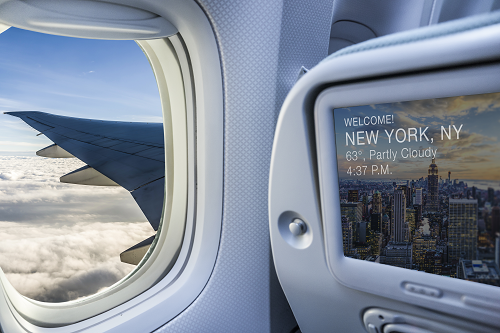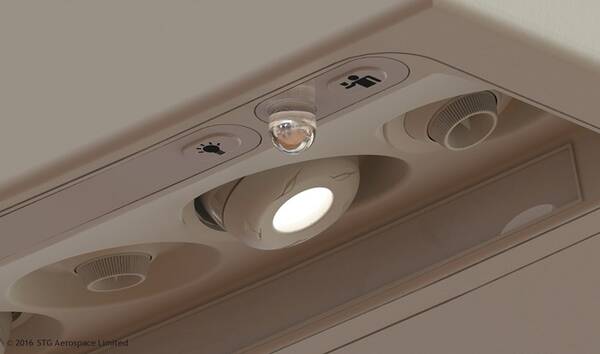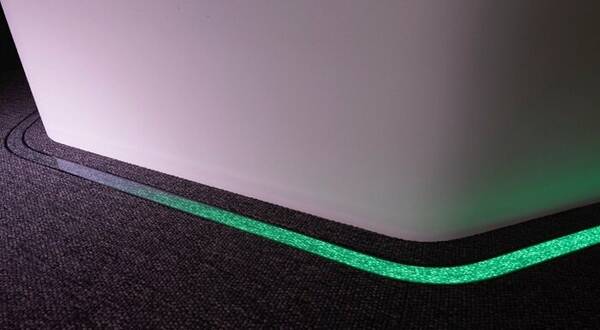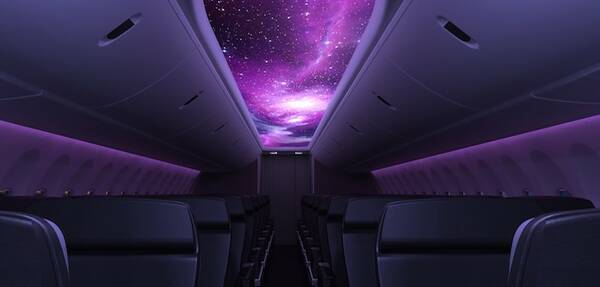Setting the Mood: Aircraft Interior Lighting Trends
Air travel can be an uncomfortable experience, and these days passenger anxiety is running high with pandemic concerns. Interior cabin lighting can be an important factor in helping to create a more relaxing, comfortable atmosphere aboard flights. Light—including qualities such as brightness, saturation, and hue—has been shown in multiple studies to affect human moods, energy levels, appetite, and circadian rhythms. How an aircraft’s cabin lighting is designed and moderated over the course of a journey can make a big difference in the passenger experience.
For example, “night travel at cruising altitudes requires adequate illumination for rendering best passenger service. Thus, cabin lighting is an integral part of providing the best in-flight experience. A good lighting system provides pleasant travel experience and helps the passengers to undertake various leisure activities.”1 Recognizing the importance of interior lighting, airlines are upgrading, redesigning and adopting advanced cabin lighting to increase customer satisfaction levels.2

Interior lighting conditions can affect the visibility of both installed displays and passengers’ personal devices.
As a result, the cabin lighting category has become the fastest growing segment of the aircraft lighting market.3 Overall, the aircraft cabin lighting market is projected to grow at a CAGR of 5.2%, reaching $1.74 billion in revenues by 2026.4
The Rise of LED Lighting
Aircraft interior lighting designers have been creative, applying both the latest research and the latest technology to enhance cabin appearance, convenience, and function. In particular, LEDs have rapidly come to dominate the aircraft lighting market, due to several factors. They are more energy efficient (requiring less of the limited amount of power allotted to all aircraft systems for the duration of a flight) and can produce brighter light than traditional (incandescent) bulbs.
Additionally, LEDs have significantly longer life than traditional bulbs. In fact, “conventional incandescent lights have a lower average Mean Time Between Failures (MTBF) of approximately 1,000 hours, which is equivalent to 1-2 years. After installation, incandescent lights are required to be regularly checked and replaced after their life cycle, or in case of complete failure or even when the intensity of the light is reduced. On the other hand, LED lights have an average MTBF of approximately 10,000 hours or 10 years, which is equivalent to the life cycle of an aircraft.”5 In many cases, LEDs can be installed in an aircraft during initial production, and then will never have to be replaced while in service. For airlines, this reduces maintenance time and replacement costs.

An LED reading light from STG with a unique square-beam design that minimizes light spilling over into the space of neighboring passengers. (Image © STG Aerospace Limited, Source)
One newer lighting technology that has come into increasing use is photoluminescent strips for floor path lighting—these are the strips installed on the cabin floor to guide passengers to emergency exits in the event of a cabin light failure. Photoluminescent strips don’t require electrical power and are far lighter than previous light strips (lighter weight cuts down on the amount of fuel required by an aircraft in flight).
For example, “Lufthansa is manufacturing the GuideU non-electrical floor path making system, which is lightweight and can be easily installed and deployed in all common line-fit aircraft platforms. The system does not require a power source, has an unlimited lifetime, is lightweight, and requires zero maintenance. The emergency exit signs of Lufthansa offer all the benefits of the floor path marking system.”6

Lufthansa’s photoluminescent floor path marking (Image: Lufthansa)
Trends in Cabin Mood Lighting
A big trend is using projections to create mood lighting effects. Among airlines, Virgin America became known as one of the early practitioners of mood lighting, with its signature purple and red cabin lighting. Manufacturers such a Boeing have also been creating innovative lighting and projection systems for several years that allow its customers to customize the passenger experience.

Rockwell Collins developed the Secant Luminous Panel, which lights up the cabin ceiling with high-resolution images, such as these from Boeing’s “Skies and Stars” Cabin Animation Lighting design. (Image: Rockwell Collins)
Any frequent flyer has experienced that moment of shock when all the lights suddenly come on in what was a darkened cabin. Now, lights throughout the cabin can be programmed to coordinate with projected images, making nuanced adjustments. For example, lighting can create a gradual “sunrise” inside the cabin as a flight transitions through time zones.
Lighting effects can provide additional design benefits, for example “projections can so dramatically change the aircraft cabin’s appearance, airlines can use out-of-catalogue surfaces. This would make the aircraft interior more interesting and far less confining for passengers, without added weight or complicated certification processes.”7
LED and Lighting System Measurement and Harmonization
To be effective, advanced aircraft lighting designs require precise brightness and color specifications, which are consistent throughout the cabin. To achieve this, lighting elements need to be carefully tested and measured. Individual LEDs and fixtures are tested during production for initial quality control. Then, any replacement or retrofit lighting elements also need to be tested during installation to ensure harmonization with existing fixtures.
Photometric imaging systems such as Radiant’s ProMetric® Imaging Photometers and Colorimeters are efficient solutions for measurement of light sources during manufacture or at any location within the aircraft including cockpits, cabins, galleys, lavatories, ceilings, aisles, walls, and overhead, ensuring adequate illumination for all in-flight functions.
Interior lighting must provide adequate illuminance relative to the installation distance or angle in an aircraft to ensure specifications are met. Light that is too bright, or poorly directed, may not meet specifications for aircraft operation. Uniformity in illuminance and color is also important for both function and quality perception. Luminous intensity distribution patterns mapped by Radiant ProMetric imaging systems ensure appropriate brightness and distribution patterns in design, manufacture, and installation of lighting systems, correlating light source characterization data from R&D to production. These systems capture a complete light source or light source distribution in a single image, gathering millions of data points at once to evaluate brightness, color, color temperature, illuminance, luminous intensity, and dimensional qualities of the source output.
A photometric imaging solution enables rapid light source characterization and quality control, regardless of the size, shape, or distribution of a source. To learn more, watch our Webinar, which presents solutions for light source measurement that are applicable to both aerospace and automotive interiors. It includes demonstrations of test sequences applied to measurement images in software to evaluate multiple qualities of each light sources, such as:
- Evaluating the qualities of multiple LEDs at once (in arrays or on PCBs)
- Measuring reflections and light scatter on interior surfaces

CITATIONS
- Global Aircraft Cabin Lighting Market: Opportunities and Forecasts 2019-2026, Allied Market Research, August, 2019.
- Kollau, R., “Boeing’s next-gen mood lighting uses light projection to animate the aircraft cabin,” Airline Trends, January 24, 2016.
- Aircraft Lighting Market by Aircraft Type (Commercial, Military, Business Jets & General Aviation, Helicopters), Light Source (LED, Fluorescent), Light Type (Interior Lights, Exterior Lights), End User (OEM, Aftermarket), Region-Global Forecast to 2030, Markets and Markets, July 2020.
- Global Aircraft Cabin Lighting Market: Opportunities and Forecasts 2019-2026, Allied Market Research, August, 2019.
- Aircraft Lighting Market by Aircraft Type (Commercial, Military, Business Jets & General Aviation, Helicopters), Light Source (LED, Fluorescent), Light Type (Interior Lights, Exterior Lights), End User (OEM, Aftermarket), Region-Global Forecast to 2030, Markets and Markets, July 2020.
- Ibid.
- Quoting airline journalist Marsia Garcia of FlightChic, in Kollau, R., “Boeing’s next-gen mood lighting uses light projection to animate the aircraft cabin,” Airline Trends, January 24, 2016.
Join Mailing List
Stay up to date on our latest products, blog content, and events.
Join our Mailing List
